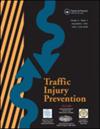影响孟加拉国脑外伤患者严重程度和预后的因素:一项基于机构的横断面研究。
IF 1.6
3区 工程技术
Q3 PUBLIC, ENVIRONMENTAL & OCCUPATIONAL HEALTH
引用次数: 0
摘要
目的:创伤性脑损伤(TBI)对孟加拉国患者来说是一个障碍,因为该国各地区缺乏相关设施和专科医生。本研究旨在记录孟加拉国创伤性脑损伤患者一年来的不同属性,即他们的损伤特征、接受的治疗,并了解这些属性对创伤性脑损伤严重程度的影响:这项横断面研究在达卡一家三级医院接受治疗的 280 名创伤性脑损伤患者中进行。医生分别根据格拉斯哥昏迷量表(GCS)和格拉斯哥结果评分(GOS)确定了创伤性脑损伤的严重程度和预后:与南亚国家以往的研究一样,大多数创伤性脑损伤患者为男性(76.1%),年龄在 18 岁至 50 岁之间(52.2%)。然而,因道路交通事故(RTA)导致的创伤性脑损伤的发病率(67.9%)远高于南亚的早期研究。此外,与之前的研究相比,有更多的患者患有严重创伤性脑损伤(29.3%)和中度创伤性脑损伤(35.7%),并且有更高比例的患者接受了手术(56.8%)。双变量分析发现,人口统计学特征(居住地)和临床特征(受伤后的意识、CT 扫描结果和治疗类型)与创伤性脑损伤的严重程度有明显关联。此外,临床特征(创伤性脑损伤病因、伤后意识、治疗类型和创伤性脑损伤严重程度)与创伤性脑损伤预后也有明显的相关性。多变量分析表明,创伤后昏迷且 CT 扫描观察到明显脑损伤的患者患中度或重度创伤后脑损伤的风险大大高于轻度创伤后脑损伤。此外,RTA 或跌倒导致的创伤性脑损伤、CT 扫描中发现明显脑损伤、手术后癫痫发作以及中度或重度创伤性脑损伤的患者,其预后不利的风险明显高于中度残疾患者:本研究发现,区域性交通事故是造成创伤性脑损伤的主要原因。此外,研究还发现了一些可能决定孟加拉患者创伤性脑损伤严重程度和预后的变量。应进一步研究这些变量与创伤性脑损伤的相关性,希望能采取措施减少创伤性脑损伤事件,并改善对创伤性脑损伤的管理,从而减轻总体负担。本文章由计算机程序翻译,如有差异,请以英文原文为准。
Factors affecting severity and prognosis of traumatic brain injury among Bangladeshi patients: An institution based cross-sectional study
Objective
Traumatic brain injury (TBI) proves to be an obstacle for Bangladeshi patients due to the lack of facilities and specialist doctors in regional sections of the country. This study aimed to record different attributes of Bangladeshi TBI patients over a year i.e., their injury characteristics, treatments received and understand their impacts on the severity of TBI.
Method
This cross-sectional study was carried out among 280 TBI patients treated in a tertiary care hospital in Dhaka. The physicians determined TBI's severity and prognosis as per the Glasgow Coma Scale (GCS) and Glasgow Outcome Score (GOS) respectively.
Results
Most TBI patients were male (76.1%) and aged between 18 and 50 years (52.2%), as in previous studies in South Asian countries. However, the prevalence of TBI due to road traffic accidents (RTAs) was much higher (67.9%) than in the earlier studies in South Asia. Additionally, more patients suffered from severe TBI (29.3%) and moderate TBI (35.7%), and a higher percentage of patients went through surgery (56.8%) compared to previous studies. A significant association of demographic (residence) and clinical characteristics (consciousness after injury, CT scan findings and treatment type) with the severity of TBI was found in bivariate analysis. It also revealed the significant dependence of clinical characteristics (TBI etiology, post-injury consciousness, treatment type and TBI severity) on TBI prognosis. Multivariate analysis showed that patients who were unconscious after TBI and with evident brain injury observed in CT scans have a substantially higher risk of having moderate or severe TBI than mild TBI. Moreover, patients with TBI due to RTAs or falls, evident brain injury in CT scans, post-surgical seizure, and moderate or severe TBI have a significantly higher risk of getting a more unfavorable TBI prognosis than moderate disability.
Conclusions
In this study, RTAs were found to be the major cause of TBI. Additionally, some variables were identified as possible determinants of TBI severity and prognosis among Bangladeshi patients. The correlation of these variables with TBI should be further studied with the hopes that steps will be taken to reduce TBI incidents and improve its management to reduce the overall burden.
求助全文
通过发布文献求助,成功后即可免费获取论文全文。
去求助
来源期刊

Traffic Injury Prevention
PUBLIC, ENVIRONMENTAL & OCCUPATIONAL HEALTH-
CiteScore
3.60
自引率
10.00%
发文量
137
审稿时长
3 months
期刊介绍:
The purpose of Traffic Injury Prevention is to bridge the disciplines of medicine, engineering, public health and traffic safety in order to foster the science of traffic injury prevention. The archival journal focuses on research, interventions and evaluations within the areas of traffic safety, crash causation, injury prevention and treatment.
General topics within the journal''s scope are driver behavior, road infrastructure, emerging crash avoidance technologies, crash and injury epidemiology, alcohol and drugs, impact injury biomechanics, vehicle crashworthiness, occupant restraints, pedestrian safety, evaluation of interventions, economic consequences and emergency and clinical care with specific application to traffic injury prevention. The journal includes full length papers, review articles, case studies, brief technical notes and commentaries.
 求助内容:
求助内容: 应助结果提醒方式:
应助结果提醒方式:


